机械工程专业英语文本施平10
- 格式:doc
- 大小:32.00 KB
- 文档页数:5
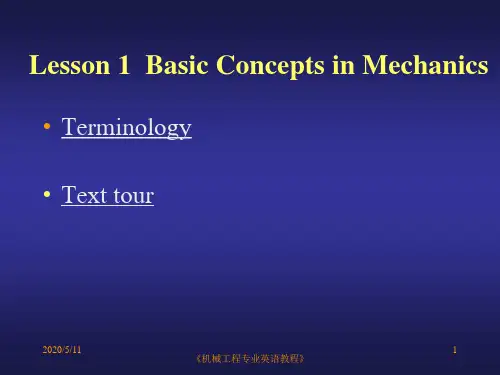

Metal-Cutting ProcessMetal-cutting processes are extensively used in the manufacturing industry.They are characterized by the fact that the size of the original workpiece is sufficiently large that the final geometry can be circumscribed by it, and that the unwanted material is removed as chips, particles, and so on. The chips are a necessary means to obtain the desired tolerances, and surfaces. The amount of scrap may vary from a few percent to 70%--80% of the volume of the original work material.Owing to the rather poor material utilization of the metal-cutting processes, the anticipated scarcity of materials and energy, and increasing costs, the development in the last decade has been directed toward an increasing application of metal-forming processes. However, die costs and the capital cost of machines remain rather high; consequently, metal-cutting processes are, in many cases, the most economical, in spite of the high material waste, which only has value as scrap. Therefore, it must be expected that the material removal processes will for the next few years maintain their important position in manufacturing. Furthermore, the development of automated production systems has progressed more rapidly for metal-cutting processes than for metal-forming processes.In metal-cutting processes, the imprinting of information is carried out by a rigid medium of transfer, which is moved relative to the workpiece, and the mechanical energy is supplied through the tool. The final geometry is thus determined from the geometry of the tool and the pattern of motions of the tool and the workpiece. The basic process is mechanical: actually, a shearing action combined with fracture.As mentioned previously, the unwanted material in metal-cutting processes is removed by a rigid cutting tool, so that the desired geometry, tolerances, and surface finish are obtained. Examples of processes in this group are turning, drilling, reaming, milling, shaping, planning, broaching, grinding, honing, and lapping.Most of the cutting or machining processes are based on a two-dimensional surface creation, which means that two relative motions are necessary between the cutting tool and the work material. These motions are defined as the primary motion, which h mainly determines the cutting speed, and the feed motion, which provides the cutting zone with new material.In turning the primary motion is provided by the rotation of the workpiece, and in planning it is provided by the translation of the table; in turning the feed motion is a continuous translation of the tool, and in planning it is an intermittent translation of the tool.《机械工程专业英语》哈尔滨工业大学出版社施平金属切削加工金属切削加工在制造业中等到了广泛的应用。
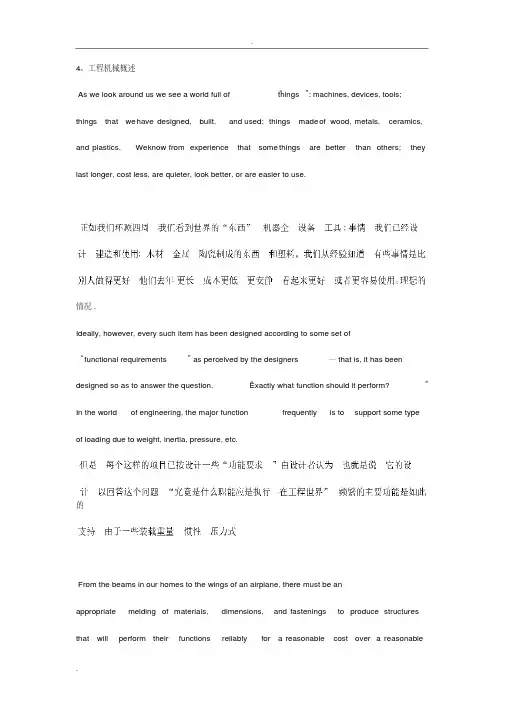
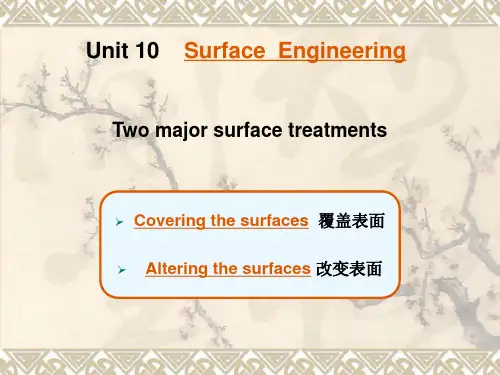
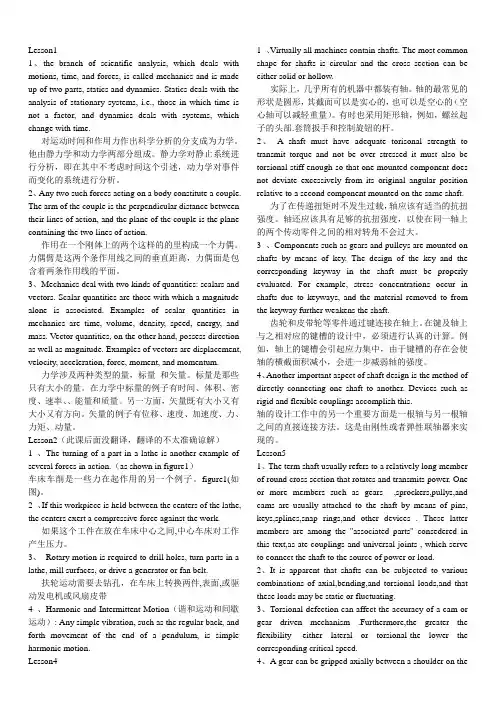
Lesson11、the branch of scientific analysis, which deals with motions, time, and forces, is called mechanics and is made up of two parts, statics and dynamics. Statics deals with the analysis of stationary systems, i.e., those in which time is not a factor, and dynamics deals with systems, which change with time.对运动时间和作用力作出科学分析的分支成为力学。
他由静力学和动力学两部分组成。
静力学对静止系统进行分析,即在其中不考虑时间这个引述,动力学对事件而变化的系统进行分析。
2、Any two such forces acting on a body constitute a couple. The arm of the couple is the perpendicular distance between their lines of action, and the plane of the couple is the plane containing the two lines of action.作用在一个刚体上的两个这样的的里构成一个力偶。
力偶臂是这两个条作用线之间的垂直距离,力偶面是包含着两条作用线的平面。
3、Mechanics deal with two kinds of quantities: scalars and vectors. Scalar quantities are those with which a magnitude alone is associated. Examples of scalar quantities in mechanics are time, volume, density, speed, energy, and mass. Vector quantities, on the other hand, possess direction as well as magnitude. Examples of vectors are displacement, velocity, acceleration, force, moment, and momentum.力学涉及两种类型的量,标量和矢量。
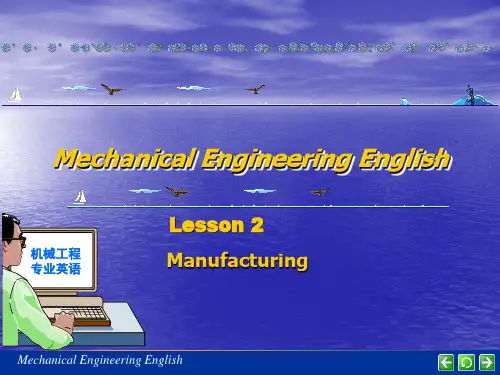
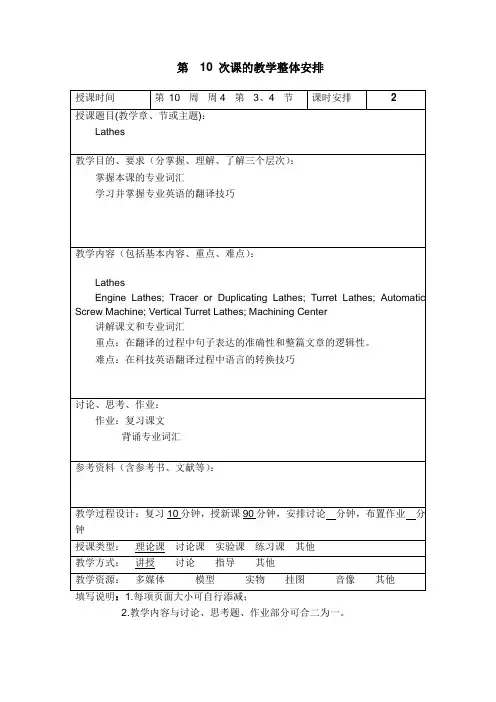
第10 次课的教学整体安排2.教学内容与讨论、思考题、作业部分可合二为一。
14 Lathes车床Lathes are widely used in industry to produce all kind of machined parts. Some are general-purpose(通用的) machines, and others are used to perform highly specialized operations.Engine Lathes普通车床Engine lathes, of course are general-purpose machines used in production and maintenance shops all over the world. Sizes range from small bench models to huge heavy-duty(重型的) piece of equipment. Many of the larger lathes come equipped with attachments not commonly found in the ordinary shop, such as automatic stops for the carriage.Tracer or Duplicating Lathes仿形/靠模车床The tracer or duplicating lathe is designed to produce irregularly shaped parts automatically. The basic operation of this lathe is as follows: A template(模板、模型) of either a flat or three-dimensional shape is placed in a holder. A guider or pointer(仿形指) then moves along this shape and its movement controls that of the cutting tool. The duplication may include a square or tapered(锥形的) shoulder(台肩), grooves, tapers(锥体), and contours. Works such as motor shafts, spindles, pistons, rods, car axles, turbine shafts, and a variety of other objects can be turned using this type of lathe.Turret Lathes 转塔车床A Turret lathe is basically similar to an engine lathe except that the conventional tool post is replaced with a hexagonal turret, which can be rotated around a vertical axis as required. Appropriate tools are mounted on the sixsides of the turret. The length of each tool is so adjusted that by simply indexing(转动) the turret, any tool can be brought in exactly the desired operating condition. Those cutting tools can, therefore be employed successively(依次地) without the need for dismounting the tool and mounting a new one each time, as the case with conventional engine lathe. This result in an appreciate saving in the time required for setting up the tools. Also, on a turret lathe a skilled machinist is required only initially to set up the tools. (对刀) A laborer with limited training can operate the turret lathe thereafter and produce parts identical to those that can be manufactured when a highly skilled machinist operates the lathe.Automatic Screw Machine自动切丝机Screw machine are similar in construction to turret lathe, except that their heads are designed to hold and feed long bars of stock. Otherwise, there is little difference between them. Both are designed for multiple tooling, and both have adaptations for identical work. Originally, the turret lathe was designed as a chucking lathe for machining small castings, forgings, and irregularly shaped work piece. The first screw machines were designed to feed bar stock and wire used in making small screw parts. Today, however, the turret lathe is frequently used with a collet attachment, and the automatic screw machine can be equipped with a chuck to hold castings.The single-spindle automatic screw machine, as its name implies, machines work on only one bar of stock at a time. A bar 16 to 20mfeet long is fed through the headstock spindle and is held firmly by a collet. The machining operations are done by cutting tools mounted on the turret and on the cross slide. When the machine is in operation, the spindle and the stock are rotated atselected speeds for different operations. If required, rapid reversal of the spindle is also possible.In the single-spindle automatic screw machine, a specific length of stock is automatically fed through the spindle to a machining area. At this point, the turret and the cross slide move into position and automatically perform whatever operation are required. After the machined piece is cut off, stock is again fed into the machining area and the entire cycle is repeated.Multiple-spindle automatic screw machines have four to eight spindles located around a spindle carrier. Long bar of stock, supported on the rear of the machine, pass through these hollow spindles and are gripped by collets. With the single-spindle machine, the turret indexes around the spindle. When one tool on the turret is working, the others are not. With a multiple-spindle machine, however, the spindle itself indexes. Thus the bars of stock are carried to the various end-working and side-working tools. Each tool operates in only position, but all tools operate simultaneously. Therefore, four to eight work pieces can be machined at the same time.Vertical Turret Lathes立式转塔车床A vertical turret lathe is basically a turret lathe that has been stood on its headstock end. It is designed to perform a variety of turning operations. It consists of a turret, a revolving table, and a slide head with a square turret for holding additional tools. Operations performed by any of the tools mounted on the turret or side head can be controlled through the use of stops.Machining Center(MC加工中心)Many of today’s more sophisticated lathes are called machining centers since they are capable of performing, in addition to the normal turning operations,certain milling and drilling operations. Basically, a machining center can be thought of as being a combination turret lathe and milling machine. Additional features are sometimes included by manufacturers to increase the versatility of their machines.(FMS F lexible M anufacturing S ystem柔性制造系统)(HSC H igh S peed C utting 高速切削)。
![[新版]机械工程专业英语教程(第2版)[施平主编][翻译]_lesson12](https://uimg.taocdn.com/62824efc18e8b8f67c1cfad6195f312b3169eb4d.webp)
Spur GearsGears , defined as toothed members transmitting rotary motion from one shaft to another , are among the oldest devices and inventions of man . In about 2600 B.C. , the Chinese are known to have used a chariot incorporating a complex series of gears . Aristotle , in the fourth century B.C. , wrote of gears as if they were commonplace . In the fifteenth century A.D. , Leonardo da Vinci designed a multitude of devices incorporating many kinds of gears .齿轮,在最古老的设备和发明人中,被定义为通过轮齿将旋转运动从一根轴传递到另一根轴,大约在公元前2600年,中国人就知道用战车组成一系列复杂的齿轮系。
西元前四世纪,亚里士多德记述了齿轮就好像是他们司空见惯的一样。
在十五世纪,达芬奇设计了大量的包含各种各样齿轮的设备。
Among the various means of mechanical power transmission (including primarily gears , belts , and chains ) , gears are generally the most rugged and durable . Their power transmission efficiency is as high as 98 percent . On the other hand , gears are usually more costly than chains and belts . As would be expected , gear manufacturing costs increase sharply with increased precision -- as required for the combination of high speeds and heavy loads , and for low noise levels . ( Standard tolerances for various degrees of manufacturing precision have been established by the AGMA , American Gear Manufacturers Association. )在众多的机械传动方式中(包括齿轮传动,带传动,链传动),一般来说,齿轮是最经久耐用的,它的能量传递效率高达98%。
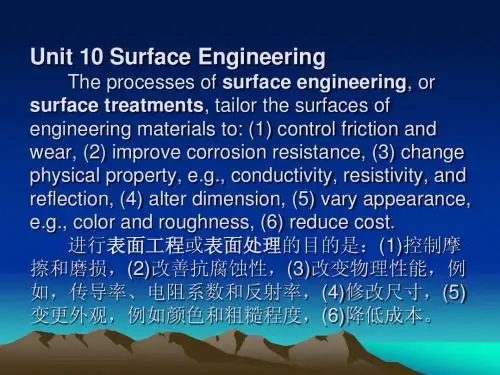
![机械工程专业英语教程 (第5版)课件 (10)[9页]](https://uimg.taocdn.com/9501d180e45c3b3566ec8b3d.webp)
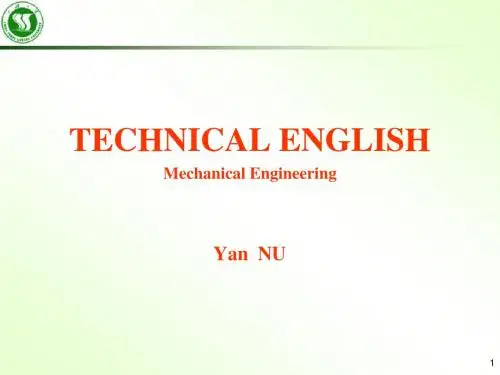
施平机械工程专业英语教程Introduction to Mechanical EngineeringChapter 1: Introduction to Mechanical Engineering- Definition and scope of mechanical engineering- Historical background and evolution of the field- Overview of various disciplines within mechanical engineering Chapter 2: Mechanics- Principles of mechanics, including statics and dynamics- Laws of motion and their applications- Analysis of forces and moments in mechanical systems Chapter 3: Thermodynamics- Basic concepts and laws of thermodynamics- Energy and heat transfer in mechanical systems- Analysis of thermodynamic cycles and processesChapter 4: Materials Science and Engineering- Properties and behavior of materials used in mechanical engineering- Material testing and characterization methods- Selection of materials for specific applicationsChapter 5: Fluid Mechanics- Fundamentals of fluid mechanics- Analysis of fluid flow and pressure distribution- Applications of fluid mechanics in mechanical systems Chapter 6: Heat Transfer- Modes of heat transfer (conduction, convection, radiation)- Heat transfer analysis and calculations- Applications of heat transfer in mechanical systemsChapter 7: Energy Conversion and Power Systems- Energy conversion principles and devices- Analysis of power generation systems- Renewable energy sources and sustainabilityChapter 8: Machine Design and Control Systems- Design principles and methodologies for mechanical systems- Control systems and automation in mechanical engineering- Analysis and optimization of machine componentsChapter 9: Manufacturing Processes- Various manufacturing processes and methodologies- Machining, forming, casting, and joining processes- Quality control and inspection in manufacturingChapter 10: Engineering Ethics and Professionalism- Ethical considerations in engineering practice- Professional responsibility and accountability- Society and the engineer's role in sustainable development Chapter 11: Career Opportunities in Mechanical Engineering- Overview of career options and paths in mechanical engineering - Skills and qualities desired by employers- Professional organizations and resources for career advancement Chapter 12: Emerging Technologies in Mechanical Engineering- Trends and developments in the field of mechanical engineering - Introduction to advanced technologies like robotics, nanotechnology, and artificial intelligence- Potential impact of these technologies on the future of mechanical engineering.。
Gear Materials (Reading Material)齿轮材料(阅读材料)Gears are manufactured from a wide variety of materials, both metallic as well as nonmetallic.齿轮由多种种类的材料制造,包括金属材料和非金属材料。
As is the case with all materials used in design, the material chosen for a particular gear should be the cheapest available that will ensure satisfactory performance.在设计中可以使用多种材料的情况下,对于特定齿轮,应当做到选用满足使用要求下的最便宜的材料。
Before a choice is made, the designer must decide which of several criteria is most important to the problem at hand.在作出选择前,设计师必须决定在众多设计准则中哪个是当前最重要的。
If high strength is the prime consideration, a steel should usually be chosen rather than cast iron.如果高强度是第一要考虑的因素,通常就选择钢材而不选择铸铁。
If wear resistance is the most important consideration, a can be made, for problems involving noise reduction, nonmetallic. Materials perform better than metallic ones.如果耐磨性是最重要的因素,可以选用非金属材料要比金属材料更好,同时也可以解决降低噪声的问题。
机械工程专业英语第二版必考翻译(完整版)1.With low-power machinery or vehicles the operator can usually apply sufficient force through a simple mechanical linkage from the pedle or handle to the stationary part of the brake. In many cases, however, this force must be multiplied by using an elaborate braking system.(P5)用低能机器或传力工具,操作者通过向踏板或把手的一个简单机械连接构件作用足够的力量到车闸固定的部分。
大多数情况,然而,用一个详细(复杂)的车闸系统使这个力量成倍增加。
2. The fundamental principle involved is the use of pressed air acting through a piston in a cylinder to set block brakes on the wheels. The action is simultaneous on the wheels of all the cars in the train. The pressed air is carried through a strong hose from car to car with couplings between cars; its release to all the separate block brake units, at the same time, is controlled by the engineer. (Braking Systems)(P5)相关的基本原理是使用压缩气体,通过气缸内的活塞将闸块压在车轮起作用。
机械工程专业英语文章随着全球化进程的加快及新型工业化道路的发展,我国劳动力市场对机械工程人才的就业能力提出了更高的要求。
下面是店铺带来的机械工程专业英语文章,欢迎阅读!机械工程专业英语文章精选Milling and Milling Cutter铣削和铣刀Milling is a machining process that is carried out by means of a multiedge rotating tool known asa milling cutter.铣削是采用被称为铣刀的多刃旋转刀具完成的机加工作业。
In this process, metal removal is achieved through combining the rotary motion of the millingcutter and linear motions of the workpiece simultaneously. Milling operations are employed inproducing flat, contoured and helical surfaces as well as for thread- and gear-cuttingoperation.在此工艺中金属去除是通过铣刀的旋转运动和工件的直线运动的组合实现的。
铣削作业既可用于生成平面、轮廓面和螺旋面也可用于切削螺纹和齿轮。
Each of the cutting edges of a milling cutter acts as an individual single-point cutter when itengages with the workpiece metal. Therefore, each of those cutting edges has appropriaterake and relief angles.在铣刀切削工件金属时铣刀的每条切削刃都象一单独的单刃刀具一样作用。
第10 次课的教学整体安排2.教学内容与讨论、思考题、作业部分可合二为一。
14 Lathes车床Lathes are widely used in industry to produce all kind of machined parts. Some are general-purpose(通用的) machines, and others are used to perform highly specialized operations.Engine Lathes普通车床Engine lathes, of course are general-purpose machines used in production and maintenance shops all over the world. Sizes range from small bench models to huge heavy-duty(重型的) piece of equipment. Many of the larger lathes come equipped with attachments not commonly found in the ordinary shop, such as automatic stops for the carriage.Tracer or Duplicating Lathes仿形/靠模车床The tracer or duplicating lathe is designed to produce irregularly shaped parts automatically. The basic operation of this lathe is as follows: A template(模板、模型) of either a flat or three-dimensional shape is placed in a holder. A guider or pointer(仿形指) then moves along this shape and its movement controls that of the cutting tool. The duplication may include a square or tapered(锥形的) shoulder(台肩), grooves, tapers(锥体), and contours. Works such as motor shafts, spindles, pistons, rods, car axles, turbine shafts, and a variety of other objects can be turned using this type of lathe.Turret Lathes 转塔车床A Turret lathe is basically similar to an engine lathe except that the conventional tool post is replaced with a hexagonal turret, which can be rotated around a vertical axis as required. Appropriate tools are mounted onthe six sides of the turret. The length of each tool is so adjusted that by simply indexing(转动) the turret, any tool can be brought in exactly the desired operating condition. Those cutting tools can, therefore be employed successively(依次地) without the need for dismounting the tool and mounting a new one each time, as the case with conventional engine lathe. This result in an appreciate saving in the time required for setting up the tools. Also, on a turret lathe a skilled machinist is required only initially to set up the tools. (对刀) A laborer with limited training can operate the turret lathe thereafter and produce parts identical to those that can be manufactured when a highly skilled machinist operates the lathe.Automatic Screw Machine自动切丝机Screw machine are similar in construction to turret lathe, except that their heads are designed to hold and feed long bars of stock. Otherwise, there is little difference between them. Both are designed for multiple tooling, and both have adaptations for identical work. Originally, the turret lathe was designed as a chucking lathe for machining small castings, forgings, and irregularly shaped work piece. The first screw machines were designed to feed bar stock and wire used in making small screw parts. Today, however, the turret lathe is frequently used with a collet attachment, and the automatic screw machine can be equipped with a chuck to hold castings.The single-spindle automatic screw machine, as its name implies, machines work on only one bar of stock at a time. A bar 16 to 20mfeet long is fed through the headstock spindle and is held firmly by a collet. The machining operations are done by cutting tools mounted on the turret and on the cross slide. When the machine is in operation, the spindle and the stock are rotatedat selected speeds for different operations. If required, rapid reversal of the spindle is also possible.In the single-spindle automatic screw machine, a specific length of stock is automatically fed through the spindle to a machining area. At this point, the turret and the cross slide move into position and automatically perform whatever operation are required. After the machined piece is cut off, stock is again fed into the machining area and the entire cycle is repeated.Multiple-spindle automatic screw machines have four to eight spindles located around a spindle carrier. Long bar of stock, supported on the rear of the machine, pass through these hollow spindles and are gripped by collets. With the single-spindle machine, the turret indexes around the spindle. When one tool on the turret is working, the others are not. With a multiple-spindle machine, however, the spindle itself indexes. Thus the bars of stock are carried to the various end-working and side-working tools. Each tool operates in only position, but all tools operate simultaneously. Therefore, four to eight work pieces can be machined at the same time.Vertical Turret Lathes立式转塔车床A vertical turret lathe is basically a turret lathe that has been stood on its headstock end. It is designed to perform a variety of turning operations. It consists of a turret, a revolving table, and a slide head with a square turret for holding additional tools. Operations performed by any of the tools mounted on the turret or side head can be controlled through the use of stops. Machining Center(MC加工中心)Many of today’s more sophisticated lathes are called machining centers since they are capable of performing, in addition to the normal turning operations,certain milling and drilling operations. Basically, a machining center can be thought of as being a combination turret lathe and milling machine. Additional features are sometimes included by manufacturers to increase the versatility of their machines.(FMS F lexible M anufacturing S ystem柔性制造系统)(HSC H igh S peed C utting 高速切削)。